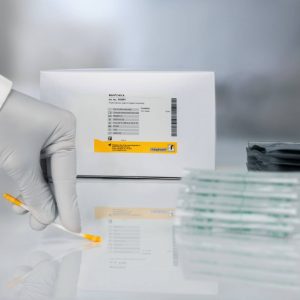Promedia ST-25 (Swab Test)
0,01 €Sampling device consisting of sterile swab in 10 ml sterile PBS buffer for quantitative detection of microorganisms in environmental samples in combination with Compact Dry medium systems.
Microbiological tests for cleaning and hygiene control detect general residues of foods on insufficient cleaned surfaces in the production environment. These residues of nutrients are the basis for growth of microorganisms.
Colony counting in foods or on surfaces can be done using the ready-to-use Compact Dry plates. Compact Dry plates are available for 13 different parameters of analysis. General method base of examinations with Compact Dry is the cultivation of microorganisms on standard nutrient media. The test principle is based on specific chromogenic substrates which are converted into colored products by the metabolism of microorganisms. Beside examination of diluted food samples, Compact Dry is also suited for swab samples from surfaces or incubation of membrane filter samples from liquids.
Residues of foods on surfaces can be detected using protein tests (RIDA®CHECK) or ATP measurements (LuciPac™ A3 Pens / LuciPac® Pens). Determination of proteins roughly describes the stage of contamination by color change of the colorimetric detection reagent. However, the relative amount of ATP (Adenosintriphosphat) or AMP (Adenosinmonophosphat) respectively can be measured very precisely. A special bioluminescence reaction which requires the presence of ATP or AMP is recorded in a special luminometer instrument (Lumitester SMART). Both systems are suited for consistent control of efficiency of cleaning procedures. These controls ensure maintenance of general industrial hygiene. Surfaces which are hygienically clean can reduce the risk of product contaminations.
RIDA®CHECK is a rapid swab test for monitoring the efficiency of surface cleaning procedures in the production environment. The test is intended to be used as a support for hygiene monitoring as well as general protein screening in allergen management.
Showing all 2 results
Sampling device consisting of sterile swab in 10 ml sterile PBS buffer for quantitative detection of microorganisms in environmental samples in combination with Compact Dry medium systems.

RIDA®CHECK is a rapid swab test for monitoring the efficiency of surface cleaning procedures in the production environment. The test is intended to be used as a support for hygiene monitoring as well as general protein screening in allergen management.